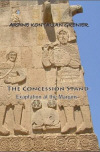The Concession Stand
Arpine Konyalian Grenier’s fourth full-length book, The Concession Stand: Exaptation at the Margins, is a genre-bending collection of what can best be described as lyric essays. In essence, the pieces in this book are enacting the exaptation that they advocate: the exaptation of language to connect with a collective identity, one that allows for new ways of communication that are not hindered by culture/hierarchy/power/history but are inclusive to all.
Arpine Konyalian Grenier’s fourth full-length book, The Concession Stand: Exaptation at the Margins, is a genre-bending collection of what can best be described as lyric essays. In essence, the pieces in this book are enacting the exaptation that they advocate: the exaptation of language to connect with a collective identity, one that allows for new ways of communication that are not hindered by culture/hierarchy/power/history but are inclusive to all.
Often, Grenier’s essays are multifarious, employing English, Spanish, Arabic, and Turkish languages (to name a few) in exploration of the roots of language/meaning:
We are discussing yapmak (to make) versus etmek (to do). Nefret emtek (to hate) has been interesting for me because in Turkish, nefret (hate) becomes a verb only with the auxiliary, etmek. For the verb “to hate,” I prefer to utilize the auxiliary yapmak (have a poem titled, nefret yapmak) because I feel hate does not come from a natural action, that it takes effort to hate. So, “making” hate makes more sense than “doing” hate, I say.
At times, Grenier’s essays can seem disjointed and highly complex (if not “difficult”) and cannot (should not) be read quickly. Here, in the essay “Heritage Like Money Then: Risk to Reward,” we see such disjoint:
Identity, like money, is utilized then. Commemoration is needed no more. We are response-able then, after choices, not after burden or fault or blame or praise. We have no “truth” but a place to stand, a place of grace we give ourselves. We have power, elastic, interwoven. Then again, how do we come in? Lucifer, bringer of light, enlighten us to merge what is scholarly with what is literally, with what is human.
She also “splices” the essays with verse, which adds to the characteristic lyric essay “leaps”:
While the mist of philosophy hovers around art, there is a lag/space between cultural practice and its theorization, similar to the lag between poetry and literature. Personal and cultural histories linger in the body memory of the poet who is trans-national. There, histories fall apart as they come together, and they come together as they fall apart. There, a de-territorialization in space only poetry (art) can reach, matter passing into sensation , faceless, genderless, voiceless, awaiting a future that’ll be a new version of itself—a pattern, not the thread. Because one writes, not because of political or social systems, but because love and death are at the door, and hope. Hope from or for X, always. The trans-nationality of Celan gives Celan (the urge). How is that for me—beggar, gusto con justo.
if then you scrapped it all
love wills through still
long time bristled
edges of
wit
frayed virus
no longer some slanted
sky elegy of more
in the form of
now
But, ultimately, Grenier’s use of repetition (insistence) helps to pull together each piece of an essay so that when it is considered as a whole, the essay connects to us and we find an understanding; thus, “the music flows, means what it does not say, the aspects are convincing.” This is the trademark craft of a lyric essayist, one who writes to make meaning only when the reader steps back to look at the collective: “a pattern, not the thread.”
The use of repetition not only occurs within individual pieces, but also among and between all of the essays in the book, so one could argue that the book itself is not a collection of separate essays; rather, it is one essay; the text itself has a collective identity.
These textual characteristics are what embody and enact the “exaptation at the margins,” Grenier’s call for us to denounce our language expectations, developed from culture, hierarchical rules and past experience, and expand into a new language that is not culture—or gender—specific. This, she writes, is the language of the poet, derivative of “a longing to negotiate the multivariate nature of realities, the elements, how divergent they are, where they are.”
There is genuine brilliance at every turn of the page: these pieces may not be read quickly; they need to be parsed out little by little, in order to allow the reader time to digest “that new song, that new language.” The Concession Stand opens a can of worms in the reader’s brain—we consume it when it aligns with our psyche, our understanding of our world (when it aligns with our memory, mirrors us, when the signifier connects with our signified). And it does so, taking a stand against Baudelarian theories of the lyric “being rarely in rapport with the reader’s experience.”
Grenier’s new lyric language takes us to “a new space-time at the concession stand,” paradoxically yielding to language and culture (history, memory) while maintaining a stand, an identity within the collective. It is “the paradox of locating the site of one’s dwelling in the world by embracing self-forgetting and celebrating one’s estrangement and otherness.”





